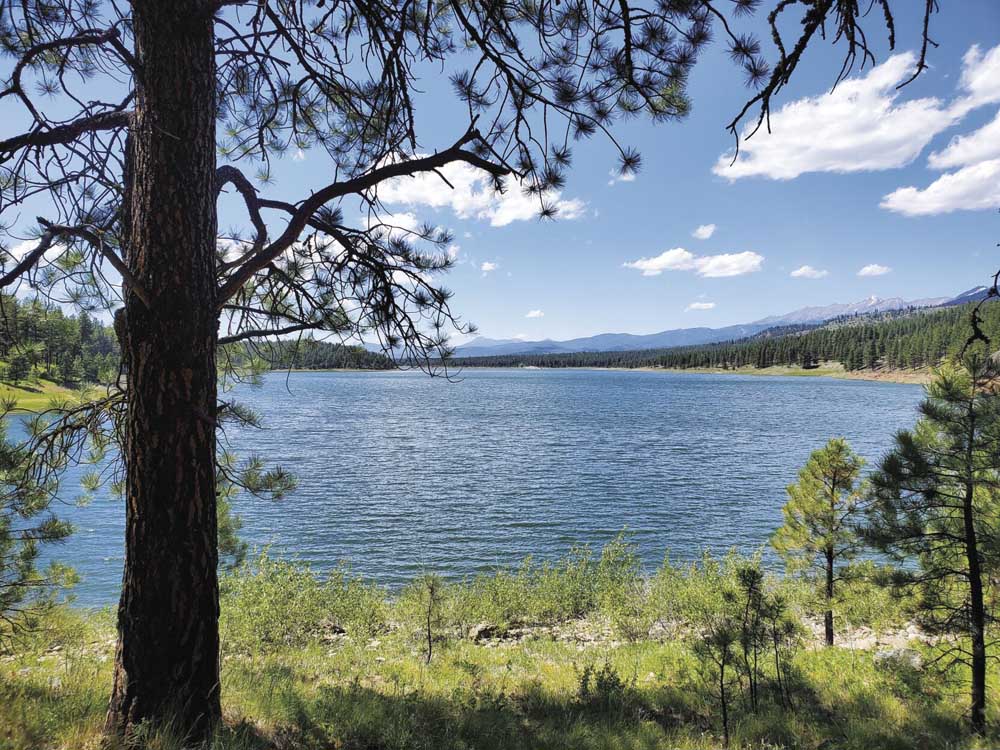Phillips Reservoir nearly matches last year’s level
Published 5:00 pm Thursday, June 13, 2024

- Phillips Reservoir was about 73% full on June 11, 2024. That’s likely to be the highest the reservoir rises this year, as the demand for irrigation water increases while inflow into the reservoir drops during the summer.
BAKER CITY — Phillips Reservoir reached almost exactly the same level this spring as it did last, but the path to that point was dramatically different.
Early in 2023 the reservoir along the Powder River, in Sumpter Valley about 17 miles southwest of Baker City, was a comparative puddle.
But it rose rapidly as melting snow swelled the river from April through mid June.
The reservoir, which supplies irrigation water to about 30,000 acres, mostly in Baker Valley, peaked at 53,603 acre-feet on June 16, 2023.
Although that’s well below full pool of 73,000 acre-feet, it was the most water the reservoir had held since early August 2017.
(Phillips can actually store an additional 17,000 acre-feet if needed for flood control. One acre-foot of water would cover one acre of flat ground to a depth of one foot. One acre-foot equals almost 326,000 gallons.)
The Baker Valley Irrigation District, which regulates releases from the reservoir, kept the biggest “carryover” in six years — water left in the reservoir after the irrigation season ends in late summer.
Phillips dropped to a miminum of just under 23,000 acre-foot in October 2023.
That’s much more water than it held in previous autumns.
In 2022, for instance, after two years of drought, the reservoir was about as low as it has been since Mason Dam was finished in 1968, with less than 1,000 acre-feet of stored water.
Given the greater carryover, the reservoir looked much different in the spring of 2024.
On March 31, it held 39,000 acre-feet.
One year earlier the volume was 4,900 acre-feet.
But last year the mountain snowpack was deeper, and more persistent.
On March 31, 2023, the water content in the snow at an automated measuring station near Bourne, about 6 miles north of Sumpter, reported 19.5 inches of water content.
April was cooler and wetter than usual, and by April 30 the water content at Bourne had dropped only slightly, to 16 inches.
This spring, by contrast, the water content at Bourne was 14 inches on March 31.
And a month later the snow was gone.
“Every darn year has a different twist,” said Jeff Colton, who manages the Baker Valley Irrigation District. “That’s why you can never predict.”
The skimpier snowpack this year not only affected how much water flowed in the Powder River, the main source for the reservoir, Colton said.
A scarcity of snow at lower elevations, downstream from the reservoir, also has an effect.
Although that melted snow doesn’t end up in the reservoir, it does augment the Powder River’s flow, Colton said, which means he can wait longer to start releasing water from the reservoir to meet the irrigation demand.
“That low (elevation) snow means a lot,” he said.
Colton said the 2015 Cornet-Windy Ridge fire, which scorched much of the timber in the Dooley Mountain area, has had a significant effect. With few trees left to shade the ground, he said the snow melts earlier in the spring. Once that snow is gone, the reservoir is the main source of water to keep the Powder flowing at sufficient levels.
The peak flow on the Powder at Hudspeth Lane, just above the reservoir, topped 550 cubic feet per second at its peak in 2023. The daily average flow exceeded 200 cfs on 48 straight days, starting on April 27, 2023.
This spring, though, the daily average surpassed 200 cfs on just six days, May 14-19, and it never exceeded 250 cfs.
And so, even though the reservoir was much closer to full at the start of this spring compared with 2023, the comparatively paltry flow on the Powder River meant Phillips didn’t gain nearly as much this spring as last.
The reservoir reached what almost certainly will be its 2024 peak, 53,404 acre-feet, on May 18.
That’s slightly below last year’s maximum, and it happened almost a month earlier than the apex in 2023.
That’s due in part to the Powder River’s flow petering out sooner.
But it also reflects the earlier demand for water from downstream farmers and ranchers.
Last spring the weather was so cool and damp that irrigators didn’t need water from the reservoir.
But April 2024 was much warmer than April 2023 — the average high temperature at the Baker City Airport was 6.6 degrees higher in April 2024.
In 2023, the irrigation district, to meet the demand, increased the water release from the reservoir to 200 cfs on May 23, with a peak of 252 cfs on May 31.
In 2024, though, the release reached 200 cfs nine days earlier, on May 14, and topped 300 cfs from May 16-19.
Although he would of course have preferred that the reservoir fill this year for the first time since 2017, Colton said the situation is vastly better than the period 2020-22, when filling Phillips was a fantasy.
The peak in 2020 was 42,742. The next two years were especially dismal, with maximum volumes of:
• 2021 — 16,632 acre-feet on April 26.
• 2022 — 18,850 acre-feet on June 23.
As in 2023, Colton said he’s looking forward to keeping a similar amount of water in the reservoir after the current irrigation season.
“It’s nice to have a bit in your savings account,” he said.
Having the reservoir nearly three-quarters full as summer approaches is a boon for recreation as well as for irrigation, Colton said.
Boat ramps just above the dam and at Union Creek Campground, on the north shore, are both usable.
Other reservoirs
As was the case last year, most other reservoirs in and near Baker County filled this spring. That includes Unity, in southern Baker County, Thief Valley near North Powder, and Pilcher Creek and Wolf Creek reservoirs west of North Powder.
“We’re in good shape,” said Doug Birdsall, manager of the Powder Valley Water Control District, which includes Pilcher Creek and Wolf Creek reservoirs.





